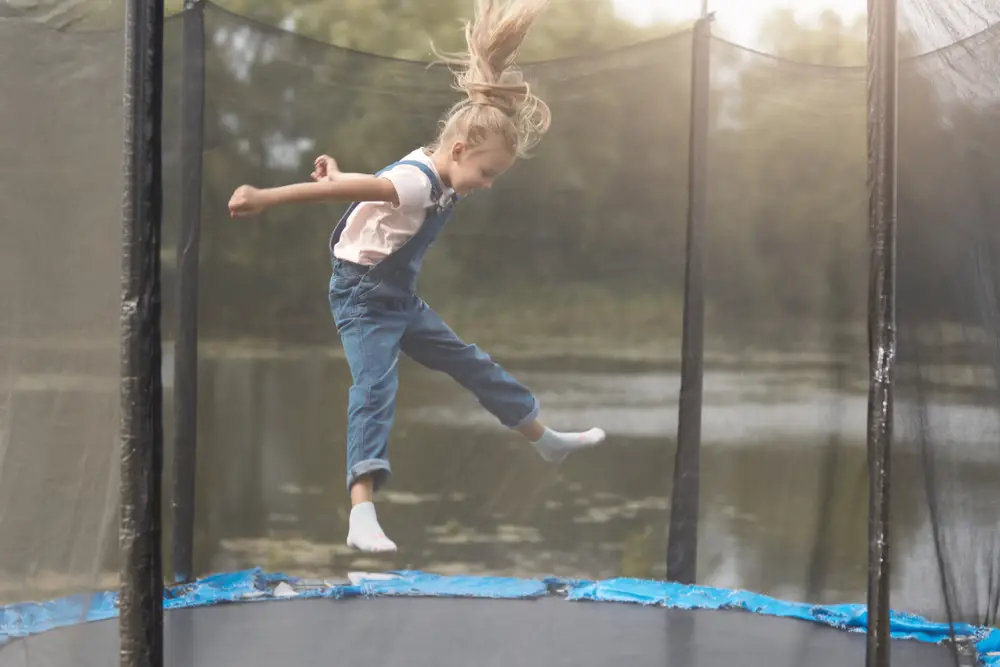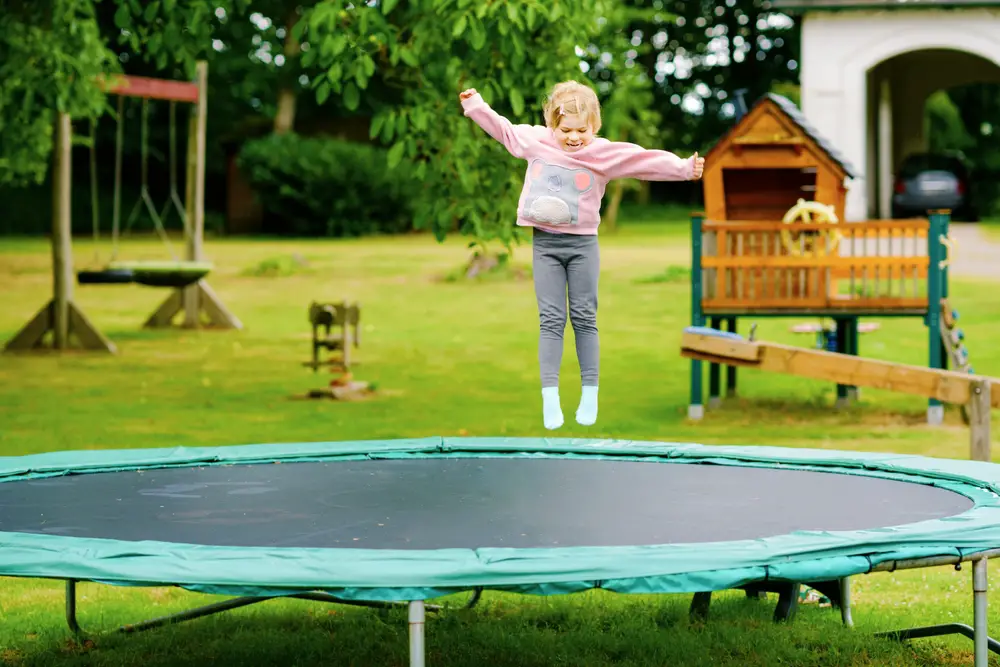Chances are that you remember that one neighbor as a kid who had a trampoline in their backyard, and it was most likely everyone’s favorite place to hang out. As you get older and have kids of your own, you may start considering whether you should become that neighbor and get a trampoline.
The trampoline is great summer fun for kids and teenagers alike. However, you shouldn’t impulsively buy the first trampoline you see. It’s essential to do your research to understand what is required to own a trampoline and how to do so safely, including figuring out which type of trampoline is right for your family.
Don’t know where to start? Consider this your trampoline complete guide. Keep reading to learn everything you need to know about trampolines, including:
- What is a trampoline?
- Why get a trampoline?
- The different types of trampolines
- How to use a trampoline safely
- And more!
By the end, you’ll have all the information you need to help you decide whether a trampoline is the right addition to your backyard and how to get one.
What Is a Trampoline?
Let’s start this complete trampoline guide with the basics: What is a trampoline?
A trampoline is a device on which you jump up and down as a form of activity. Trampolines are made from a strong, resistant piece of cloth held by strings on a frame.
There’s evidence of trampolining occurring possibly hundreds of years ago, with the earliest evidence being Inuit people tossing dancers on a walrus skin as a form of celebration.
Trampolines are used in various sports; notably, trampolining is an Olympic sport. George Nissen and Larry Griswold developed the first modern trampoline around 1934 at the University of Iowa. Initially, this device was used to train tumblers and astronauts and to improve the athleticism of other athletes such as gymnasts and divers. Only later did people enjoy it so much that it became its own sport and consequently, its own Olympic sport.
In the Olympics, athletes perform acrobatics while jumping up and down on a trampoline. This requires extreme athleticism, but jumping on a trampoline for leisure doesn’t require any athletic training.
Trampolining is a suitable activity for all ages. Better yet, they make a great addition to any backyard. Let’s take a look at the reasons why you might consider getting a trampoline for your backyard.
Reasons to Get a Trampoline
There are a million and one reasons to get a trampoline, and if you have children, chances are that they’ve already tried giving you a few reasons of their own why you should get one.
Trampolines can genuinely be a good investment for your backyard and your family. Trampolining may eventually become a regular hobby. To help you decide whether they are suitable for you, here are a few top reasons why you should consider getting a trampoline.
Exercise
As fun as it is, jumping on a trampoline is an excellent form of exercise. Trampoline exercises boost cardiovascular health, improve endurance, and relieve stress and tension by targeting your back, core, and legs.
These benefits apply no matter what sized trampoline you choose – from a mini to a large trampoline.
Enhance motor skills
Jumping on a trampoline is also a great way to enhance your children’s motor skills. Trampoline jumping helps with muscle development, strengthens bones, and reinforces joints. What’s more, trampoline jumping also improves your child’s coordination and balance.
Make sure you always supervise your children on the trampoline.
Relieve stress
Here’s a way that trampolining can benefit adults in a similar way that it benefits kids. The specific motion of jumping up and down has a way of calming the body and helping to center your mind, which can be much needed after a day of school or work.
Release endorphins
If you think back to your memories of jumping on a trampoline, chances are that those are happy memories. Jumping on a trampoline releases mood-enhancing endorphins, especially for children.
So if your goal is to cheer up your family, a trampoline may be an excellent addition to your home!
While there are several reasons to get a trampoline, you must also understand the safety risks of having a trampoline in your yard.

The Basics of Trampoline Safety
This wouldn’t be a complete trampoline guide if we didn’t talk about the potential downside of having a trampoline – injuries.
While trampolines are a lot of fun for the entire family, unfortunately it is easy to injure oneself while using them.
Several possible injuries can occur through trampoline use. The most common type of trampoline injury is sprains – particularly ankle or foot sprains. Other common types of injury include:
- Concussion
- Dislocation
- Fractures
- Lacerations
- General pain
The good news is that trampolines are usually only dangerous when not used properly. It’s pretty easy to avoid getting injured on a trampoline when you exercise proper caution before getting on, while jumping, and while getting off of the trampoline.
There are many ways in which trampoline accidents happen. Some injuries can occur from simply jumping and landing wrong. However, most injuries occur when the trampoline isn’t used correctly, such as in the following cases:
- Performing unsafe stunts.
- Jumping too hard and falling off of the trampoline.
- Too many people colliding with each other.
Here are a few essential safety tips for using a trampoline:
- Limit the number of people allowed onto the trampoline based on the size, weight limit, and instructions.
- Ensure the trampoline is set up on a flat clear surface and away from other obstacles.
- Regularly check your trampoline and perform maintenance as necessary.
- Always supervise children while they use the trampoline.
- Avoid having other items on the trampoline while jumping, such as balls or frisbees. While it can be fun to play catch while jumping, it can be a hazard if you end up jumping on that object.
With proper use, trampolines can be a safe, family-friendly activity.
Let’s check out the different types of trampolines.
Different Types of Trampolines
One of the most challenging parts of picking a trampoline is deciding between the different types. In general, trampolines come in different shapes. Those shapes are:
- Round
- Rectangle or square
- Oval
Each of these shapes has its advantages. Let’s look at the differences between them to help with your decision.
Round

When people think of the traditional trampoline, they think round. Round trampolines are the most popular trampoline shape for families.
The best part about round trampolines is that they come in many affordable styles. They also evenly distribute weight on all springs making for potentially safer jumping.
However, something to also consider is that the round shape forces jumpers towards the middle, increasing the chance of collision and injury.
For a round trampoline to keep your family secure, consider this 15-foot Jumpflex trampoline that can hold up to 550 pounds at once and includes a 360-degree net.
Rectangle/Square

While round trampolines are the most popular for home use, rectangular trampolines are used for competitions and gymnastics.
There are several reasons you might consider a rectangular trampoline over a round one. For starters, it’s easier to spread out multiple jumpers on a rectangular trampoline than on a circular one. This shape allows bouncers to stay in one place more easily, resulting in fewer collisions.
The additional square footage provided by rectangular trampolines also makes them better suited for bouncers who want to practice their tricks. The only downside to rectangular trampolines is that they may wear down unevenly because of their uneven shape. Moreover, they are typically more challenging to set up than round trampolines.
For a unique, square shape, check out this 14-foot Skywalker trampoline with a foam pad and no-gap enclosure for extra safety.
Octagon

Not many people opt for an octagon or polygon-shaped trampoline, but there are many reasons to consider this shape.
What’s most unique about octagon trampolines is that they contain multiple distinct sides, but the shape of the jumping pad is rounded, allowing you to benefit from the even distribution of round trampolines and the minimum risk of collision of square trampolines – the best of both worlds. The only thing that’s a disadvantage is that octagon-shaped trampolines are generally more challenging to set up than other shapes.
The octagon is a popular shape for single-person trampolines, such as this OneTwoFit 51-inch octagon trampoline. This trampoline is made from strong mesh and features a spacious bouncing surface for maximum fun. It’s also an excellent trampoline for workouts, as it comes with an adjustable handlebar.
Now let’s talk about how to go about choosing the right-sized trampoline.
How to Choose the Right-Sized Trampoline
Just as they come in a variety of shapes, trampolines also come in a variety of sizes. Here are the most popular sizes of trampolines that you’ll find and how many people can bounce on them:
- 7 feet and under – One person, usually a small child
- 7-10 feet – One child, roughly 100-pound weight limit
- 11-15 feet – Two children or one adult
- 15 feet and up – Two or more children or two adults, come in various weight limits
The size of your trampoline will determine how many people can safely jump on it at once. Some trampolines are designed for one person and others designed for four to five people to jump on.
So how exactly do you choose the right-sized trampoline for your backyard? Well, start by considering factors such as:
- Number of people in your family
- Who exactly will be jumping on it
- The amount of room in your backyard
- Storage
Let’s take a closer look at how these factors affect the trampoline you choose.
Number of people in your family
The most crucial factor to consider when choosing the right-sized trampoline is how many people are in your family and, consequently, how many people will be regularly using the trampoline at a time.
If you have a small family with one child, consider a bigger trampoline if your child has friends or family over. The number of people jumping on the trampoline will also contribute to the weight limit you require from your trampoline.
Who will be jumping on it
It’s not only essential to know how many people will be jumping on your trampoline. You must also consider who will be jumping on it and when. This primarily determines the required weight limit of your trampoline.
For example, if you have three children, it’s important to distinguish whether they are young children or teenagers, as this will require a drastically different size and weight limit. The same goes for whether adults will be jumping on the trampoline, for whatever reason. If you have small children but want a trampoline that will last and your family won’t outgrow, it’s better to opt for a bigger one from the beginning.
The amount of room in your backyard
The size of your backyard is the most significant limiting factor for what type of trampoline you get – primarily what size you get.
Think about how much space you’re willing to have the trampoline take up – just because you have the space doesn’t mean you want to use it all.
You also don’t want your trampoline to be too close to any obstacles, such as a fence that may limit the bouncer’s range of motion or be a cause for injury. Measuring your backyard before you choose your trampoline is a good idea.
Storage
While some people keep their trampoline out year-round, collecting snow in the winter, others prefer to store it out of the way in a garage or basement. Therefore, when you choose a trampoline, you must ensure you have room to store it when it’s not in use.
Let’s take a look at how to take down a trampoline.
How to Take Down a Trampoline
A trampoline complete guide wouldn’t truly be complete without learning how to take down your trampoline.
The good news is that taking down a trampoline is much easier than assembling one. However, it still requires quite a bit of work.
Follow these steps to take down your trampoline:
- Clean the trampoline: It’s easier to clean it while in one piece than when it’s apart.
- Have the necessary tools around: Check the owner’s manual to see which tools you need, but you’ll most likely require at least a screwdriver or drill and a spring tool.
- Remove accessories: This includes the net and ladder, if applicable.
- Disassemble the springs: This is the trickiest part. Use your spring tool to pull the spring towards the trampoline center. Repeat the process with the other springs, then remove and fold the mat.
- Dismantle the frame: This can be done with your screwdriver and drill.
- Pack everything up: In the bag that your trampoline came in, pack the parts up and store them.

Trampoline Complete Guide – Tips for the Best Trampoline
Here are a few additional tips to help you choose whether to get a trampoline and which one is right for your family:
- Never get a used trampoline. Trampolines are prone to wear and tear, and you don’t know the extent of that wear and tear when you buy a previously used one. The money you might save is never worth the risk of getting a used trampoline.
- A trampoline left outdoors year-round will last five to eight years. It’s a good idea to disassemble and store your trampoline in the winter to increase its longevity.
- If you want your trampoline covered under your homeowner’s insurance, your rates might increase due to additional liability.
Trampoline Complete Guide FAQ
Which trampoline is best to buy?
The best trampoline for you to buy depends on your and your family’s needs. To help you out, consider the following questions:
- How many people will be jumping?
- How much yard space do you have?
- Do you have somewhere to store the trampoline?
How big are trampolines?
Trampoline sizes vary from 3 feet to over 15 feet. The size you choose depends on how many people at a time will be bouncing on it.
Pro-tip: Small trampolines are ideal for workouts.
Is a 12-foot trampoline enough for three kids?
Twelve-foot trampolines are one of the most popular sized trampolines for families.
Generally, one to two kids are ideal for a 12-foot trampoline, as that is the number of kids it can fit at a time. So if you think only two of your children will jump at a time, 12 feet is fine.
However, it’s better to consider a bigger trampoline for all three kids to jump at once to ensure everyone’s safety. It’s also more fun when everyone can jump at once!
How much should you pay for a trampoline?
When it comes to the price of a trampoline, there is an extensive range. Typically, you should be prepared to spend $200 to $1500 on an above-ground trampoline.
However, the price of a trampoline largely depends on several factors, including:
- Size
- Brand
- Whether it’s above-ground or in-ground
Conclusion: Make Trampolining Your Summer Activity
A trampoline is a wonderful addition to your backyard that your whole family will love. With so many different types, there’s bound to be one for you.
Hopefully, this complete trampoline guide has given you all the information you need to decide which trampoline is for you.






